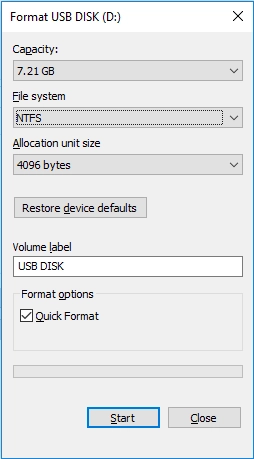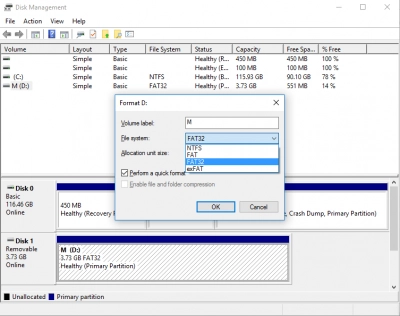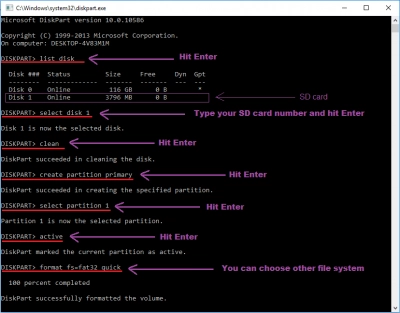‘SD card won't format’ issue occurs: your actions?
Here you will find out:
- how to deal with this issue
- how DiskInternals can help you
Are you ready? Let's read!
About the "SD card won't format" issue
An SD card is used to store and transfer information from various devices such as a tablet, camera, smartphone. And sometimes you need to format it to remove unnecessary information from the media.
You also need to format the SD card if it is damaged and use it as fresh. During the formatting process, you may encounter an unexpected error formatting the SD card, for example, "Formatting was not completed successfully." But how can this happen? This could have happened for a number of reasons. Your SD card may have been damaged by malware or a virus, or bad sectors have formed on the card as a result of the damage.
It is also possible that your sd card cannot be formatted because it is write-protected.
Here is how to fix can't format sd card error
To format your SD card, you usually need to follow the next step-by-step instructions. Open File Explorer and find the SD card you want to format. Right-click on it and select Format. A separate formatting window will open. Select File System (usually NTFS by default) and check the box next to Quick Format. After pressing the Enter button, the formatting process will begin.

If your SD card is damaged, the «Memory card not formatted». Operation failed" window will appear and the formatting process will not start. Let's figure out what to do so that the process ends successfully. First, try using a different option to format the SD card. To complete this, in your operating room the system prudently has utilities for formatting the SD card.
There are other additional applications that allow you to easily and easily format. Do not forget to make sure that there are no valuable files on your medium, they will be deleted at the end of the formatting process.
Here is how to protect your data from the loss
Sometimes it happens that when formatting an SD-card, you can delete or damage valuable information along with unnecessary data. Neither beginners nor professional users are immune from this. However, do not worry, it is quite possible to get back damaged and deleted files and folders even after formatting. For this, there is a professional program DiskInternals Uneraser.
A convenient and simple interface is available for use by a user even without advanced computer skills. For a successful recovery process, all you need to do is follow the recommendations of the recovery wizard. In addition, you have a unique opportunity to view files after recovery for free and make sure that DiskInternals Uneraser is reliable.
Only if you want to save the recovered data, you need to purchase a license key. Just enter the key, select the localization on the disk and save the information. If you have any questions, you can use DiskInternals Uneraser's technical support for free.
The card is write-protected?
There is a manual switch to protect personal information on the SD card. If it is in the enable mode, you will not be able to delete files or format. So just put it in shutdown mode and try formatting again. If it didn't work and the "Windows was unable to complete the format SD card" window pops up, go to the next step.
Use Disk Management
If you format using Windows explorer, do not worry. To accomplish this, there is a special system utility in the OS control parameters. It provides for the management of disks and partitions on them on your PC. Such a system utility can also format an SD card. To open the utility in the search engine, type Computer Management.

On the left side of the window that opens, click on Disk Management. Here you will find the required SD card. Select it and right-click, click on Format. In a new window, you need to select the file system in which the disk will be formatted (FAT32, NTFS, or exFAT). Don't forget to check "Perform Quick Format" and press Enter.
Try DiskPart
There is also a DiskPart utility with the function of formatting disk partitions. It is integrated into the latest generation operating systems and previous versions (Windows 7, 8, 10) DiskPart will handle formatting in NTFS or FAT32 file systems. But be careful if you make incorrect or erroneous changes to the command line, this will lead to a failure and loss of information in the sections.

Therefore, when working with such utilities, make backups of your valuable files in advance. Moreover, it is very dangerous if you were not previously familiar with DiskPart.
So follow the instructions. Connect your SD card to the port on your personal computer. Press simultaneously on the combination of hotkeys Windows + R. The command line will open, enter cmd, and then Ok. In the opened CMD.exe window write diskpart and Ok. You will be taken to the DiskPart command line. Enter the drive directory and then press Enter.
To format an external storage medium, enter disk X, (X is the disk number). Then you need to specify the section by entering their list Y, where Y is the section number. Click Enter and enter the format fs = NTFS quick.
Confirm by pressing Enter. When finished, enter exit in the line and confirm.
CHKDSK
If an error occurs in the formatting of the SD card and the operating system still display the message ‘The format did not complete successfully.’, try use CHKDSK. Before you run the CHKDSK, you need to know that it may be harmful to recoverable data (the ones that were deleted but still can be recovered), so if you have any files that you would like to restore - recover them before CHKDSK usage.
Then open CHKDSK which will analyze and edit all errors on the device. First, connect the SD card to your personal computer. Press the hotkeys Win + R. The command line will open and enter cmd and then click Enter. In the new window, right-click cmd and choose open with administrator rights. In the cmd.exe window type chkdsk and the name of your SD card then put a colon and \f.
Confirm by pressing the Enter key. Wait a bit while the revision and fix are done. Eventually, this command window will display "Windows has made fixes to the file system." This will open access to your SD card and you can format it as desired.
